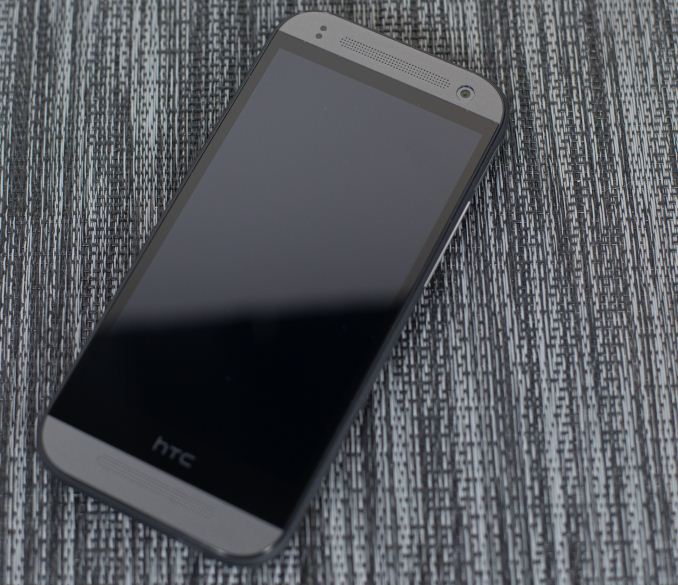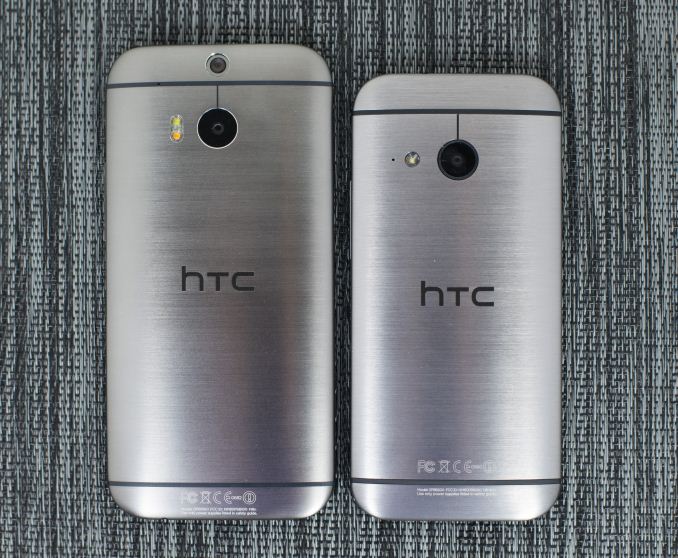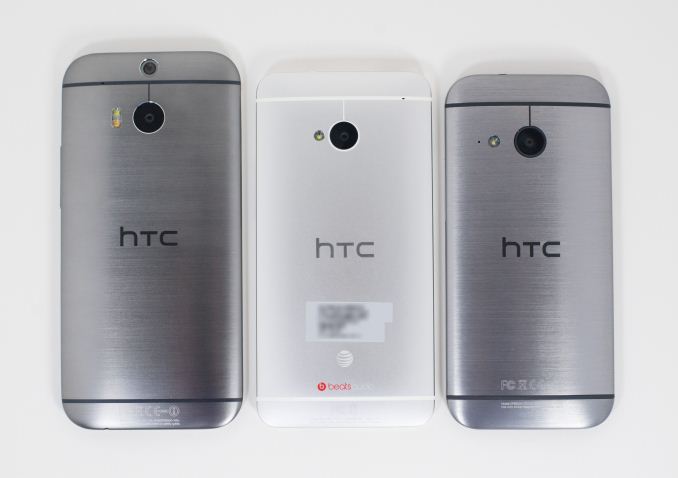HTC One mini 2 Review
by Anand Lal Shimpi & Joshua Ho on May 26, 2014 3:00 AM EST- Posted in
- Smartphones
- HTC
- Mobile
- One mini 2

Last year around this time, HTC had yet to release a mini version of its flagship phones. As OEMs continued to push bigger and bigger displays into bigger phones, there was a distinct push for a phone that had flagship specifications, but without the size that normally entailed such flagship specifications in the Android space. HTC then proceeded to launch the One mini, a phone that was the size that everyone had been asking for, but just wasn’t the same as its larger cousin. While there are now phones around the size of the One S that have flagship specs, the One mini was a distinctly midrange device, with a number of concessions made to reach a midrange price.
Of course, that was the past. Today we’re looking at the successor to the One mini. Unfortunately, for those that want everything in a One (M8) repackaged to fit into a phone the size of a One S, this is not that phone. However, the bigger question is how well this phone fits into the mid-range spectrum, and how well it compares to the competition. To this end, HTC seems to hope that better design and the halo effect from the One (M8) will differentiate the One mini 2 from the rest of the competition.
As always, the most immediate impression that one gets is from holding the phone, even before it’s turned on. In this respect, the One mini 2 is easily one of the best in its class. While it isn’t the nearly all-metal design of the M8 (50% vs 90% metal, excluding display), there’s very little plastic on the back cover, only a bit of the edge where the back cover interfaces with the rest of the phone. It’s somewhat similar to the One (M7) in this regard, although the One mini 2 has more aluminum on the side walls. The button layout is also the exact same setup as the One (M7), with a power button on the top left, 3.5mm jack on the top right, volume rocker on the right side of the phone, and the microUSB 2.0 port on the bottom right. The speaker grilles share their lineage with the One mini and One (M7), as does the layout of the speaker grilles, front facing camera, and the proximity/light sensor.
Overall, the material design and industrial design of the One mini 2 far exceeds almost anything else on the market. It’s undeniable that while some concessions have been made compared to the One (M8), in some ways the industrial design is better on the One mini 2. HTC has done a great job designing this phone.
In the hand, the size of the phone is close to the One (M7). It’s definitely a big larger in the hand when compared to the original One mini, although I’m not too sure if this is a significant difference. For those that see the iPhone 5 and 5s as the absolute largest phone that they’re willing to tolerate, this may be too much, although those that have no trouble with the Moto X and other similarly sized devices will be right at home here.
Moving past basic hardware impressions, the One mini 2 is in many ways a side-grade from the One mini. The SoC is still under the Snapdragon 400 branding, but is now a quad core Cortex A7 rather than a dual core Krait. The amount of RAM stays the same, as does display resolution. The camera is now a standard 13MP sensor with F/2.2 optics, although the front facing camera is borrowed from the One (M8) and is a good jump up from the 1.6MP camera from the One mini. A table of the hardware specifications can be seen below, along with a comparison to the One (M8) and One mini.
| HTC One mini 2 | HTC One (M8) | HTC One mini | |
| SoC | MSM8926 1.2 GHz Snapdragon 400 | MSM8974ABv3 2.3 GHz Snapdragon 801 | MSM8930 1.4 GHz Snapdragon 400 |
| RAM/NAND | 1 GB, 16GB NAND + microSD | 2GB LPDDR3, 16/32GB NAND + microSD | 1 GB LPDDR2, 16GB NAND |
| Display | 4.5” 720p LCD | 5” 1080p LCD | 4.3" 720p LCD |
| Network | 2G / 3G / 4G LTE (Qualcomm MDM9x25 UE Category 4 LTE) | 2G / 3G / 4G LTE (Qualcomm MDM9x25 UE Category 4 LTE) | 2G / 3G / 4G LTE (Qualcomm MDM9x15 UE Category 3 LTE) |
| Dimensions | 137.43 x 65.04 x 10.6mm, 137 grams | 146.36 x 70.6 x 9.35mm max, 160 grams | 132 x 63.2 x 9.25 mm, 122 grams |
| Camera | 13MP rear camera, 1.12 µm pixels, 1/3.06" CMOS size, F/2.2. 5MP f/2.0 FFC | 4.0 MP (2688 × 1520) Rear Facing with 2.0 µm pixels, 1/3" CMOS size, F/2.0, 28mm (35mm effective) and rear depth camera, 5MP f/2.0 FFC |
4.0 MP (2688 × 1520) Rear Facing with 2.0 µm pixels, 1/3" CMOS size, F/2.0, 28mm (35mm effective) no OIS 1.6 MP front facing |
| Battery | 2100 mAh (7.98 Whr) | 2600 mAh (9.88 Whr) | 1800 mAh (6.84 Whr) |
| OS | Android 4.4.2 with Sense 6 | Android 4.4.2 with Sense 6 | Android 4.4.2 with Sense 5.5 |
| Connectivity | 802.11a/b/g/n + BT 4.0, USB2.0, GPS/GNSS, MHL, DLNA, NFC | 802.11a/b/g/n/ac + BT 4.0, USB2.0, GPS/GNSS, MHL, DLNA, NFC | 802.11a/b/g/n + BT 4.0, USB2.0, GPS/GNSS, MHL, DLNA |
| SIM Size | NanoSIM | NanoSIM | MicroSIM |
The One mini 2 should be priced similarly to the original One mini at launch. HTC tells us to expect the One mini 2 to retail at £360 - £370.












76 Comments
View All Comments
devione - Monday, May 26, 2014 - link
Why, oh why, can't more manufacturers follow the Sony Z1 Compact route..Johnmcl7 - Monday, May 26, 2014 - link
I'd be interested to see the sales figures for the Z1 Compact in Europe where the phone is widely available to see if Sony's strategy of producing a flagship phone with a smaller screen has worked out for them. On paper the phone looks pretty much exactly what everyone has been wanting for a while in Android with a top end SoC, camera, micro SD, decent screen even weather sealing and without much compromise either as the price is reasonable as is the batterylife. It makes a complete mockery of the HTC Mini 2 as they both appear to be a similar price despite the Sony being a much more capable device.Yet I've not seen anyone with a Z1 Compact despite plenty of other Android phones and I've hardly seen any second hand for sale (I want a cheap one for going out cycling) whereas there's quite a few S5's around even though it's only recently released. I realise none of that's statistically relevant hence I'd like to see the sales data.
I do think Sony were too slow releasing the Z1 Compact, I think if they'd released it around two years after the Galaxy S2 they'd have been in the perfect position to catch those who wanted a similar sized phone with top end specs. I knew quite a few people who had S2's and didn't want an S4 due to the increase in size however as there wasn't anything suitable in a smaller form factor with Android they went with the S4 and find the size is fine.
A few friends and family have 'mini' phones particularly the S3 Mini and S4 Mini but they didn't just want a smaller phone they also wanted a cheap phone so wouldn't have considered a Z1 Compact if available.
Laxaa - Monday, May 26, 2014 - link
My brother just bought the Z1 Compact, and it's an impressive piece of kit. I only wish it had OIS and a better camera app(like Nokia Camera on the Lumias)Death666Angel - Monday, May 26, 2014 - link
From the article: "HTC then proceeded to launch the One mini, a phone that was the size that everyone had been asking for"From Johnmcl7: " On paper the phone looks pretty much exactly what everyone has been wanting for a while in Android".
Really? Everyone wanted a phone like that? I didn't. I was fine with 4.3" in my SGS2 when the iPhone established the 3.x" form factor. I liked my 4.65" Galaxy Nexus when that was becoming the norm and I like the 5.2" LG G2 which is doesn't feel much larger than the GN. So count me out of that "everyone" group, please. Not everyone is looking for smaller flag ship phones, just like not everyone is looking for microSD card slots, replaceable batteries or phones made out of aluminum. Some are, others aren't. I'm someone who is fine with lugging around his Nexus 7 when I'm wearing a jacket. The 5.2" G2 fits perfectly fine in all my trousers and I have never thought "bly me, that size is really bothering me".
Johnmcl7 - Monday, May 26, 2014 - link
OK, wrong turn of speech - my own phone is a Sony Z Ultra (6.4in screen) so I certainly appreciate the benefits of a larger screen.fokka - Wednesday, May 28, 2014 - link
i'm really happy for you and you're right, not "everyone" wants all those things you list. the problem is that for people who are happy with 5"+ phones there already are many options - the whole flagship-segment caters to them.but for those who want all the power in a slightly smaller form factor there is exactly one viable offering - not much considered the dozens/hundreds of models on the market. and even this lonely smartphone will be "obsolete" in a matter of months, considering the specs of current and coming flagships.
in a market like this, i think it's clear and also warranted, that people are complaining. but even if we aren't "everybody", it's still important that we voice our opinions. sorry if you felt collateralized ;)
sfuzzz - Monday, May 26, 2014 - link
I feel exactly the same. Z1 Compact is a great phone (with some flaws like other) and the right size for everyday life, you don't have to carry a bag or a jacket only for your phone. I own a Nexus 5, coming from a Xperia U (perfect size for me) and this summer will see if i go mad feeling it in my pockets all day. As for the sales (of Z1 compact) It's difficult to tell the real figures, here in Italy is available for 450/420 euros or less, but anything that is not Samsung or iPhone is a "niche" phone. I own a N5, my sister owns a Moto G, and we are considered some kind of "geeks" only for that :)Gich - Monday, May 26, 2014 - link
4xCortex-A7 can't keep up with 2xKrait 200 on benchmarks that do stress all core... and it should be worst on "normal" apps.Isn't this... very bad?
Gich - Monday, May 26, 2014 - link
Also "it’s not much of an improvement"? I feel is more of a step back.tipoo - Monday, May 26, 2014 - link
Yeah, I'd take dual krait over any number of A7 cores any day.